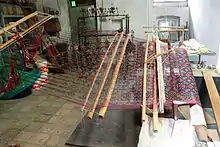Patola sari
Patola is a double ikat woven sari, usually made from silk,[1] made in Patan, Gujarat, India.[2] The word patola is the plural form; the singular is patolu.[3] They are very expensive, once worn only by those belonging to royal and aristocratic families. These saris are popular among those who can afford the high prices.[4][5] Velvet patola styles are also made in Surat. Patola-weaving is a closely guarded family tradition. There are three families in Patan that weave these highly prized double ikat saris. It is said that this technique is taught to no one in the family, but only to the sons. It can take six months to one year to make one sari due to the long process of dying each strand separately before weaving them together.Patola was woven in Surat, Ahmedabad and Patan. Highly valued in Indonesia, became part of the local weaving tradition there.
_from_Gujarat%252C_India%252C_late_18th_or_early_19th_century.jpg.webp)


The weave
To create a patola sari, both the warp and weft threads are wrapped to resist the dye according to the desired pattern of the final woven fabric. This tying is repeated for each colour that is to be included in the finished cloth. The technique of dyeing the warp and weft before weaving is called double ikat. The bundles of thread are strategically knotted before dyeing.
Patola saris from surat, Ahmedabad and Patan are renowned for their colourful diversity and geometrical style.
History
Silk weavers of the Salvi caste from the state of Maharashtra chose Gujarat as the home for their renowned patola fabric. It is believed that salvis went to Gujarat in the 12th century with the intention of acquiring the patronage of the Chaulukyas Rajputs, who ruled all of Gujarat and parts of Malva and south Rajasthan at the time, with Anahiwad Patan as the capital. Legend says that over 700 patola weavers came to the palace of Raja Kumarpal, on the personal request of king himself. [6] The Solanki(Chalukya) rulers used to dress in patola silk themselves on special occasions.
It is broadly accepted belief that these Salvis originally belonged to the region, which now lies at the middle of the present day Marathawada and Vidarbha divisions of Maharashtra state. The art of Patola weaving is an ancient one. According to some historians, the art of Patola weaving was known also in the 4th Century in “Ajanta” caves, which resembles the tie-dyes technique of patola. Ajanta Caves were patronized by the Vatsagulma branch of the Vakataka dynasty, which controlled a vast area of Deccan during the 3rd, 4th & 5th centuries A.D. Vatsagulma is presently the 'Washim' district of the Vidarbha Division of Maharashtra.
After the decline of Solanki empire, salvis founded a rich trade in Gujarat. Patola saris quickly became a sign of social status among Gujarati women and girls, especially as part of stridhan, items that a woman can claim as her. These art of patan is more than 850 years old.
Design and pattern
Patola sari is mainly use in Gujrati people & sari design is very micro and old traditional Indian culture design like old khatli design hand made silk thread use and multi color thread use the design is old Indian temple related and nature design like flower and rangolis that is main concept of sari. [7] Here are four distinct patterns which are woven primarily in Gujarat by the Salvi community. In Jain and Hindu communities, double ikat saris with entire designs of parrots, flowers, elephant and dancing figures are generally used. In Muslim communities, saris with geometric designs and flower patterns are typical, being worn mostly for weddings and other special occasions. Maharashtrian Brahmins wear saris woven with plain, dark coloured borders and body and a bird design called Nari Kunj.
References
- http://www.hindu.com/thehindu/mp/2003/04/21/stories/2003042101200200.htm
- http://www.deccanherald.com/content/302943/waves-silk-weaves.html
- Encounters with Bali, A Collector's Journey.Art Gallery, Sydney, Australia p.24
- http://www.deccanherald.com/content/306820/weaving-indian-pattern-through-textiles.
- http://www.thehindu.com/business/companies/article2500297.ece
- "History". Retrieved 19 April 2016.
- "patola sari design wholesale sari". Retrieved 2020-07-14.